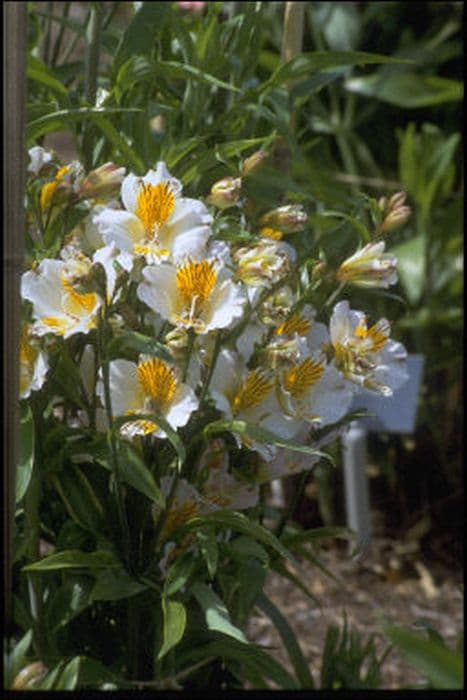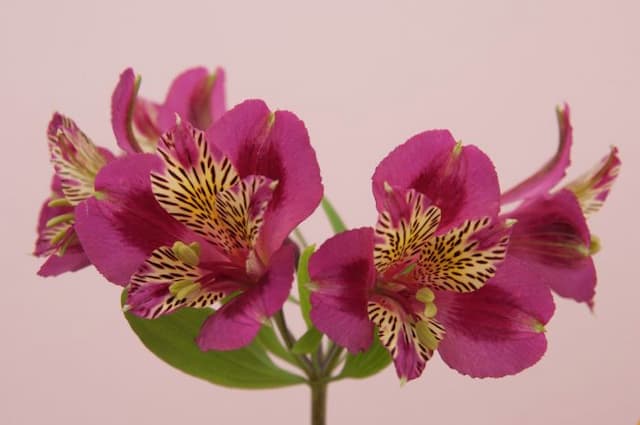Peruvian Lily Alstroemeria Inca Classic = 'Konclassic' (Inca Series)

ABOUT
The Alstroemeria Inca Classic, more commonly known as the Peruvian Lily or Lily of the Incas, is a captivating ornamental plant known for its vibrant and showy flowers. The appearance of this particular cultivar from the Inca Series is characterized by a profusion of eye-catching blooms that stand out in any garden setting. The flowers are trumpet-shaped and boast a beautiful blend of colors, typically featuring shades of yellow, pink, orange, and red, with distinctive streaks or flecks that add to their exotic charm. These flowers are often marked with contrasting colors, which create a striking pattern. These beautiful blooms are arranged in clusters at the top of slender, upright stems that emerge from a lush base of linear, lance-shaped leaves. The foliage is dark green, acting as an elegant backdrop that further accentuates the vibrancy of the flowers. The leaves are sometimes twisted or curved, giving them a unique texture and visual interest. The Peruvian Lily's overall aesthetic is one of grace and vivacity, making it an ideal choice for ornamental gardens, borders, and as a cut flower in floral arrangements due to its long vase life. Its colorful and patterned flowers add a lively touch to any setting, embodying the festive spirit associated with the native lands of this enchanting plant species.
About this plant
 Names
NamesFamily
Alstroemeriaceae
Synonyms
Peruvian Lily, Lily of the Incas, Inca Lily
Common names
Alstroemeria Inca Classic = 'Konclassic' (Inca Series).
 Toxicity
ToxicityTo humans
The Peruvian Lily (Alstroemeria) has a low level of toxicity to humans. Ingesting parts of the plant may cause mild gastrointestinal discomfort, including nausea and vomiting. While not considered highly toxic, it is still advisable to avoid eating any parts of the plant.
To pets
The Peruvian Lily is considered non-toxic to cats and dogs. However, as with any non-food plant, ingestion of large quantities may cause mild gastrointestinal upset for some pets, including symptoms like vomiting or diarrhea. It is generally safe for pets, but monitoring them to prevent ingestion is advisable as individual reactions can vary.
 Characteristics
CharacteristicsLife cycle
Perennials
Foliage type
Semi-deciduous
Color of leaves
Green
Flower color
Mixed
Height
2-3 feet (0.6-0.9 meters)
Spread
1-2 feet (0.3-0.6 meters)
Plant type
Herb
Hardiness zones
7-10
Native area
South America
Benefits
 General Benefits
General Benefits- Long blooming period: The Alstroemeria, also known as Peruvian Lily, typically has a long flowering season, bringing color to gardens for an extended time.
- Vibrant colors: It offers a wide range of colors, adding aesthetic appeal to garden spaces and floral arrangements.
- Attracts pollinators: The Peruvian Lily is known to attract bees, butterflies, and birds, which are beneficial for pollinating garden plants.
- Low maintenance: Once established, they require minimal care, making them a convenient choice for busy gardeners.
- Drought tolerant: They are relatively drought-resistant, which is advantageous in areas with water restrictions or less rainfall.
- Cutting flower: The long stems and vivid blooms make them perfect for cutting and using in bouquets and vases.
- Resistant to pests: Peruvian Lilies have a natural resistance to many pests, reducing the need for chemical treatments.
- Hardy nature: They are capable of surviving in a range of climates, making them versatile for various gardens.
 Medical Properties
Medical PropertiesThis plant is not used for medical purposes.
 Air-purifying Qualities
Air-purifying QualitiesThis plant is not specifically known for air purifying qualities.
 Other Uses
Other Uses- Photography Prop: Alstroemeria's vibrant flowers and long-lasting bloom make it excellent for use as a photography prop to add color and interest to portraits or macro photography.
- Educational Tool: Botany students can study the plant's unique form, foliar resupination, and flower structure as part of their curriculum.
- Aromatherapy Decoration: While not strongly fragrant, Alstroemeria can be included in aromatherapy arrangements for its visual appeal.
- Fine Art Inspiration: The stunning appearance of Alstroemeria can serve as inspiration for artists in painting, illustration, and textile design.
- Culinary Garnish: Edible flowers from pesticide-free Alstroemeria plants can be used to add an artistic touch to culinary presentations.
- Event Theming: Alstroemeria can be used to theme events or parties, particularly those with a South American or Incan heritage theme.
- Handicrafts: Pressed Alstroemeria flowers can be incorporated into handmade paper, bookmarks, and other delicate crafts.
- Jewelry Making: The dried petals or buds of Alstroemeria can be used in crafting unique pieces of floral jewelry such as resin pendants.
- Color Therapy: The vibrant colors of Alstroemeria can be used in color therapy and design, promoting energy and cheerfulness in living spaces.
- Greeting Cards: Fresh or dried Alstroemeria flowers can be affixed to greeting cards or used in making 3D card art for a personalized touch.
Interesting Facts
 Feng Shui
Feng ShuiThe Peruvian Lily is not used in Feng Shui practice.
 Zodiac Sign Compitability
Zodiac Sign CompitabilityThe Peruvian Lily is not used in astrology practice.
 Plant Symbolism
Plant Symbolism- Friendship: The Alstroemeria, commonly known as Peruvian Lily or Lily of the Incas, symbolizes a strong bond of friendship due to its intertwined growth habit, which suggests interlaced lives and enduring connections.
- Devotion: Peruvian Lilies are often given to show devotion and mutual support between partners, as the flower represents the commitment to help each other in times of need.
- Wealth and Prosperity: With their abundant flowers and long-lasting nature, Peruvian Lilies are symbols of wealth and prosperity, often used in bouquets and arrangements to wish someone a prosperous life.
- Achievement: The vibrant colors and upright stance of the Alstroemeria's blooms are associated with striving for success and celebrating achievements.
- Good Fortune: The Peruvian Lily is believed to bring good luck, making it a popular flower to gift when someone is starting a new venture or to simply wish them well.
 Water
WaterPeruvian lilies should be watered deeply until the topsoil feels moist, typically around once a week. During the growing season, check the soil moisture regularly, and water when the top inch starts to dry out. Adjust frequency based on weather conditions, watering more often during hot, dry spells, and reduce it during cooler, rainy periods. In terms of quantity, a good rule of thumb is to provide approximately 1 gallon of water per square foot every week during the growing season.
 Light
LightPeruvian lilies thrive in bright, indirect sunlight. The ideal location for these plants is a spot where they can receive morning sun and afternoon shade to protect them from the harsh midday sun. East-facing gardens or windows are often perfect spots, ensuring the plants get enough light without being exposed to excessive heat.
 Temperature
TemperaturePeruvian lilies perform best in temperatures between 65 and 80 degrees Fahrenheit. They can survive brief periods outside of this range, with a minimum of about 40 degrees Fahrenheit and a maximum of around 90 degrees Fahrenheit. To encourage robust growth, maintaining the ideal temperature range is crucial.
 Pruning
PruningPeruvian lilies should be pruned to remove any dead or fading flowers to encourage more blooms. Light pruning can be done throughout the growing season to maintain the plant’s shape and vigor. The best time for more extensive pruning is in late fall or early winter, after the flowering has ceased.
 Cleaning
CleaningAs needed
 Soil
SoilThe best soil mix for Peruvian Lily should be fertile, well-drained, and light. A mix of two parts loam, one part sand or perlite, and one part peat or humus is ideal. The soil pH should be slightly acidic to neutral, around 6.0 to 7.0, for optimal growth.
 Repotting
RepottingPeruvian Lilies typically need to be repotted every two to three years. Repotting helps to rejuvenate the soil and provide space for the rhizomes to expand.
 Humidity & Misting
Humidity & MistingThe Peruvian Lily thrives best in moderate humidity levels. Aim to maintain humidity around 40-60%, which is comfortable for most home environments.
 Suitable locations
Suitable locationsIndoor
Use bright indirect light, well-draining soil, and keep room temperature even.
Outdoor
Plant in partial shade, shelter from strong winds, and mulch to retain moisture.
Hardiness zone
7-10 USDA
 Life cycle
Life cycleThe Alstroemeria, commonly known as Peruvian Lily or Lily of the Incas, begins its life as a tuberous rhizome planted in well-draining soil where it undergoes a period of dormancy. Upon breaking dormancy, typically in spring, it germinates and produces shoots that grow into mature plants with long, slender leaves. As the growing season progresses, the plant develops flowering stalks adorned with funnel-shaped flowers in a variety of colors, which can occur multiple times during the warmer months. Following pollination by insects, the flowers may produce seed pods, although many cultivars are sterile and propagated primarily through division of the rhizomes. After the blooming season ends, the above-ground foliage of the Alstroemeria dies back, and the plant enters a period of dormancy, conserving energy in its rhizomes throughout the colder months. The cycle repeats annually as the rhizomes regenerate new growth each spring, leading to a perennial life span for the Alstroemeria.
 Propogation
PropogationPropogation time
Spring to Summer
The most popular method of propagation for the Peruvian Lily or Alstroemeria Inca Classic is division. This method is typically done in late winter or early spring before new growth begins. Gardeners carefully dig up the clumps of tubers, making sure to keep as many roots intact as possible. These clumps are then gently broken apart into smaller sections, ensuring that each new piece has at least one growth bud. The divisions are then replanted at the same depth they were growing previously, spaced about 12 to 18 inches (approximately 30 to 45 centimeters) apart to allow for adequate growth. This technique allows the plants to establish themselves quickly and can result in a healthy, blooming plant within the same growing season.





![Peruvian lily [H.R.H. Princess Alice]](/_next/image?url=https%3A%2F%2Fplants-admin.emdemapps.com%2Fimages%2Fplants%2F%2Fimages%2F604b55e81c8b0.png&w=640&q=75)
![Peruvian lily [Inca Coral]](/_next/image?url=https%3A%2F%2Fplants-admin.emdemapps.com%2Fimages%2Fplants%2F%2Fimages%2F604b5b79b85ce.png&w=640&q=75)
![Peruvian lily [Inca Exotica]](/_next/image?url=https%3A%2F%2Fplants-admin.emdemapps.com%2Fimages%2Fplants%2F%2Fimages%2F604b5ec0e34a9.png&w=640&q=75)
![Peruvian lily [Inca Milk]](/_next/image?url=https%3A%2F%2Fplants-admin.emdemapps.com%2Fimages%2Fplants%2F%2Fimages%2F604b5f14b0b6a.png&w=640&q=75)
![Peruvian lily [Inticancha Dark Purple]](/_next/image?url=https%3A%2F%2Fplants-admin.emdemapps.com%2Fimages%2Fplants%2F%2Fimages%2F604b5381bb78f.png&w=640&q=75)